A picture and its story 2021: Part one
From armed conflicts and protests around the globe to joyful families reuniting after separation due to coronavirus, Reuters photographers witnessed some of the most important events of the year
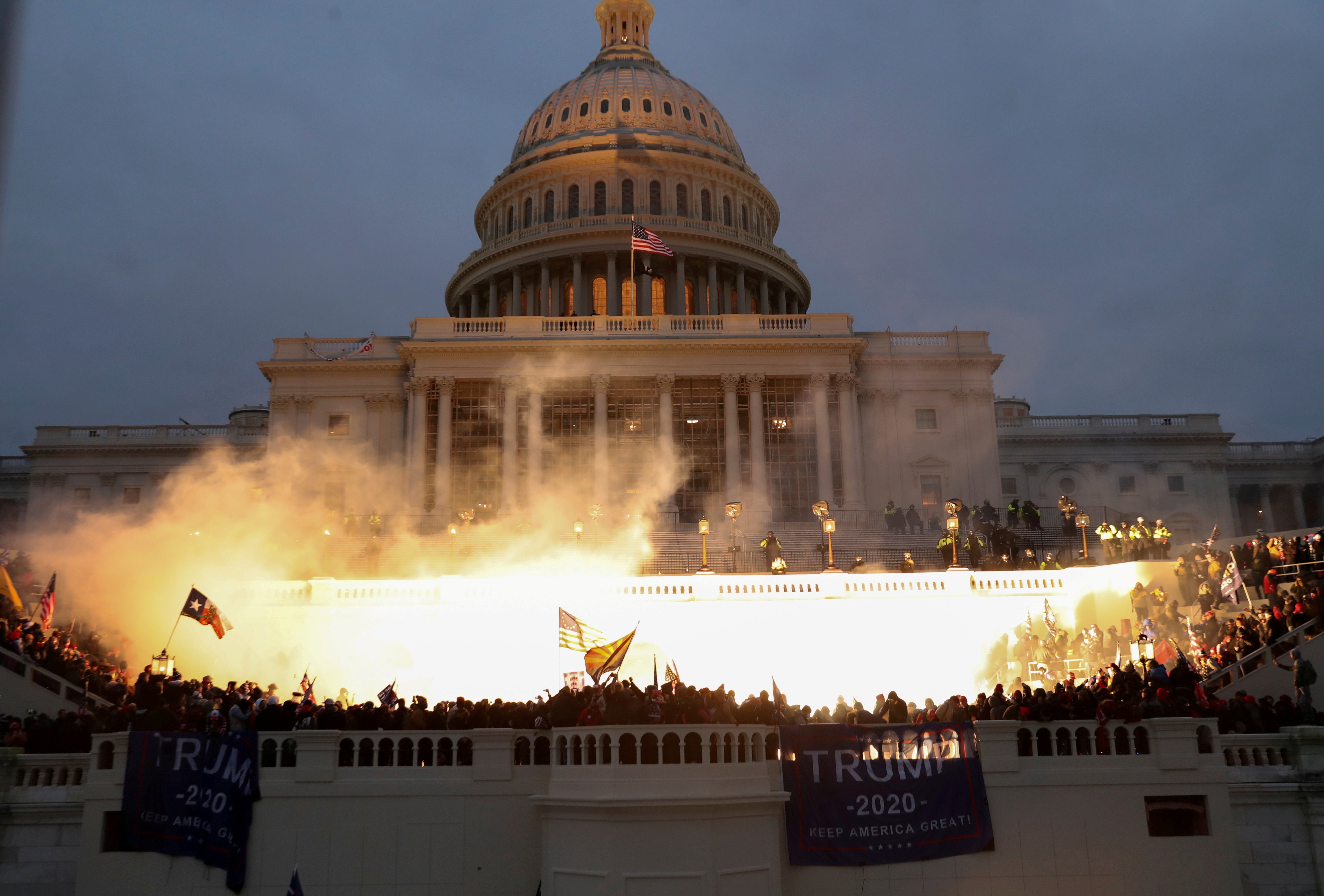
Your support helps us to tell the story
From reproductive rights to climate change to Big Tech, The Independent is on the ground when the story is developing. Whether it's investigating the financials of Elon Musk's pro-Trump PAC or producing our latest documentary, 'The A Word', which shines a light on the American women fighting for reproductive rights, we know how important it is to parse out the facts from the messaging.
At such a critical moment in US history, we need reporters on the ground. Your donation allows us to keep sending journalists to speak to both sides of the story.
The Independent is trusted by Americans across the entire political spectrum. And unlike many other quality news outlets, we choose not to lock Americans out of our reporting and analysis with paywalls. We believe quality journalism should be available to everyone, paid for by those who can afford it.
Your support makes all the difference.Photographers were in frontline trenches with Ukraine soldiers as Russian troops massed at the border. They were on the streets in Myanmar when police fired live ammunition at anti-coup protesters. They scaled scaffolding to capture images of thousands of supporters of former president Donald Trump storming the US Capitol.
Below is a selection of some exceptional Reuters pictures taken in 2021 along with the stories behind the shots, directly from the photographers who took them.
Leah Millis
Thousands of supporters of then-president Donald Trump, a Republican, stormed the US Capitol on 6 January in a failed attempt to overturn the recent election and prevent Joe Biden, a Democrat, from becoming the next president. It was the worst attack on the seat of the US government since the War of 1812.
I arrived at the west side of the US Capitol before the Trump supporters overwhelmed police lines, and I documented the chaos that ensued for the next seven hours. At one point I heard the crowd chanting “heave-ho” and thought they must be breaking in through the doors. I didn’t want to risk getting crushed or injured by the massive crowd, which was hostile toward members of the media and had already assaulted several of my colleagues that day. I chose to risk climbing some scaffolding that had been erected for the upcoming inauguration to give me a better view.
The Capitol had already been breached via different entrances, but the fight for this entrance went on for hours. Capitol and DC Metropolitan police officers engaged in hand-to-hand combat with the mob of Trump supporters and in the process multiple officers were severely injured. Four people would die that day and a police officer attacked by protesters died the next day. Four officers later took their own lives.
Eventually, law enforcement was able to successfully push the crowd back. At 5.04pm to disperse the remaining protesters, they used a flash bang grenade, which released a blinding light that illuminated the US Capitol building. To me, the explosion of the grenade captured the violence and shock of the day: American citizens attacking and breaching their own country’s Capitol building. The haunting sight of the American flag flying above the entire scene, casting a shadow onto the iconic dome behind it, is what stays with me.
There were a lot of photographers at the Capitol that day and there are many significant images from inside and outside of the building. Media outlets all over the world used this photograph and it was displayed at Trump’s second impeachment trial. The attack on the Capitol was a pivotal moment in American history and I think that we’ll look back on this day as a turning point in our country.
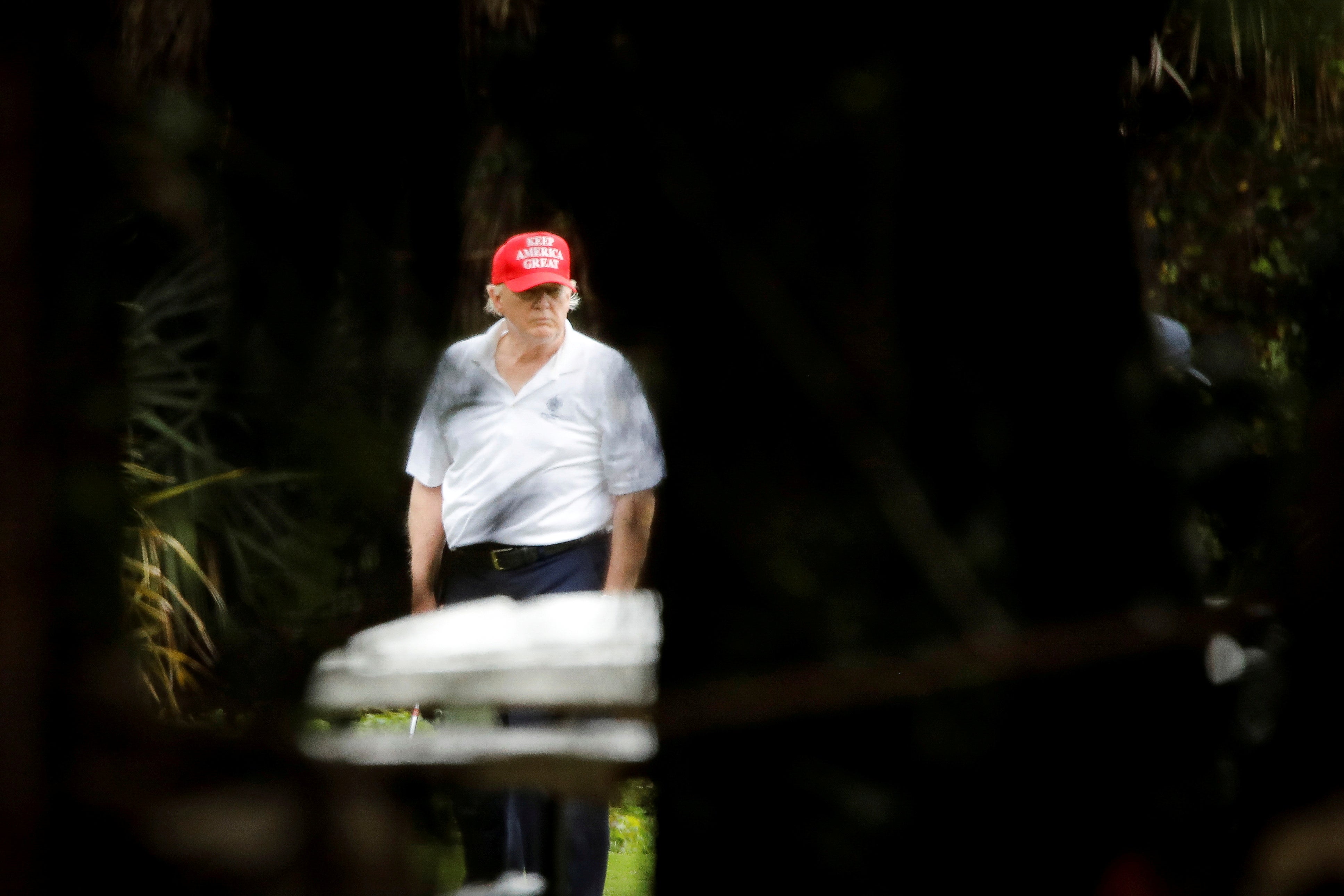
Marco Bello
As President Donald Trump travelled to Mar-a-Lago for the Christmas holiday, president-elect Joe Biden had won enough electoral votes to win the US presidency, but Trump hadn’t conceded. Nobody had access to him, not even the press pool traveling with him. The news was dominated by the election, but there weren’t any recent photos of Trump himself.
Photographer Tom Brenner, embedded in the pool, knew through a colleague about a spot in the fence of the Trump International Golf Club, from where it was possible to see Trump playing golf. I arrived at the site early Boxing Day morning on 26 December and thought: “This is an impossible shot!” There were a few holes in the thick foliage wall to see through to the golf course, but it was hard to focus the camera as any slight breeze moved the leaves and changed the focus point. The shot all depended on where the ball would land on the green, and where the secret service agents and other players would stand.
This photo was taken on my third day of shooting. By then, a couple TV crews and photographers had joined me. I learned a few things about golf from them while we spent long hours waiting.
What I love about this photo is Trump’s unkempt appearance, he just looks like a normal, regular person without the baggage of the institution that he represented.
After Trump left the White House and moved to Florida, new palm trees were seeded to fully blockade the view of the club.
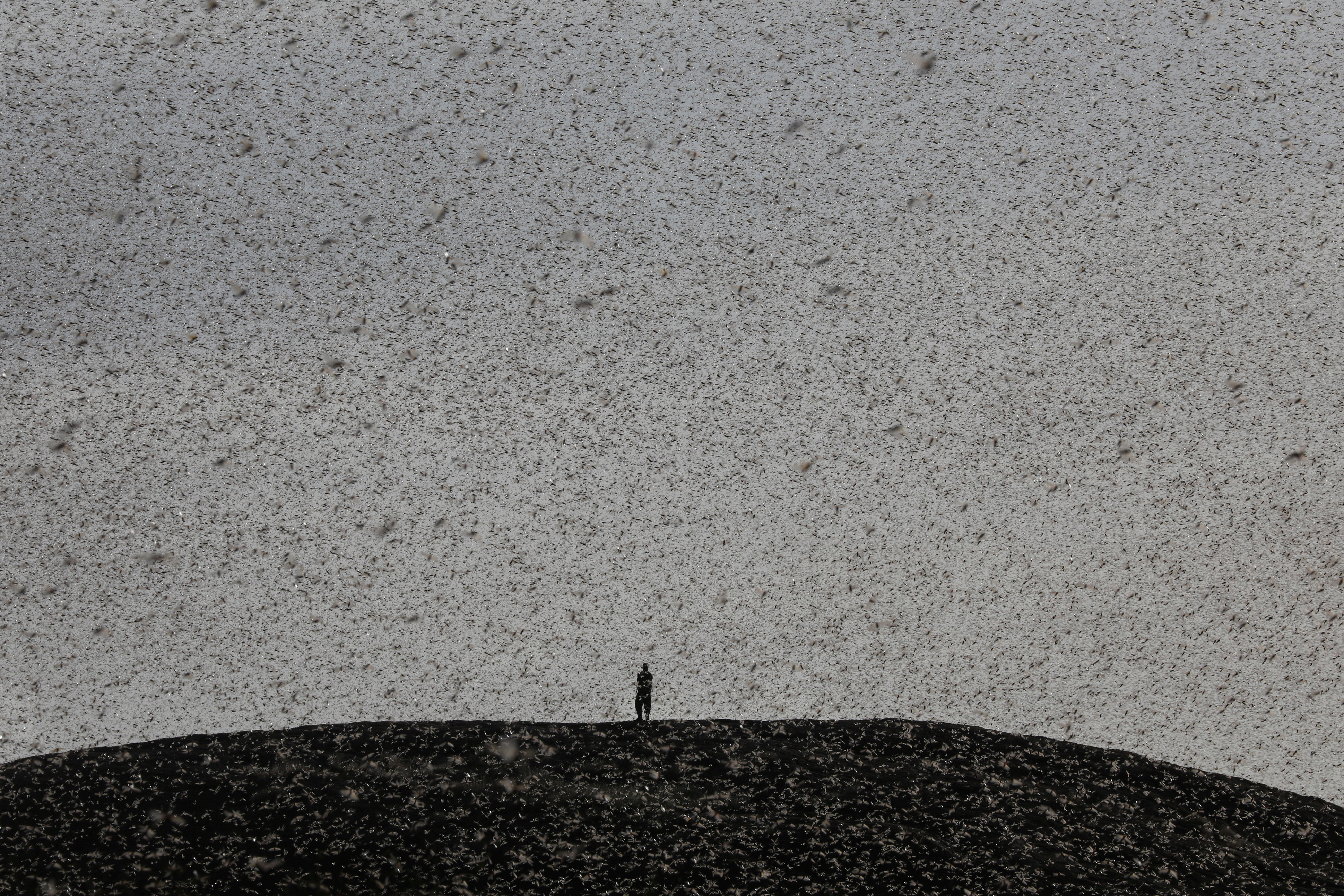
Baz Ratner
Locusts invaded eastern Africa after unusual weather patterns, exacerbated by climate change, created ideal conditions for waking dormant eggs. In Kenya, it had been decades since locusts had been seen, and they were now devastating crops and vegetation in a region that already suffers from food insecurity.
It was very difficult finding the swarms as they can travel up to 150km a day, through areas that lack roads. In some cases by the time we arrived, the swarms had already moved on. But I was lucky to find a scout who knew the terrain.
Working inside a locust swarm feels similar to standing inside a snow or hailstorm, only the sound of the locusts flying and hitting the car is much louder. They have the tendency to stick to clothes.
On this day, we were travelling along a dirt road when we found the locust swarm. I noticed an armed wildlife ranger standing on top of a hill, with locusts flying in circles around him.
I took this picture using a long lens from the bottom of the hill. I think by having the scale of a single figure, the picture illustrates the unbelievable size of a locust swarm and how this age-old infestation still affects the region.
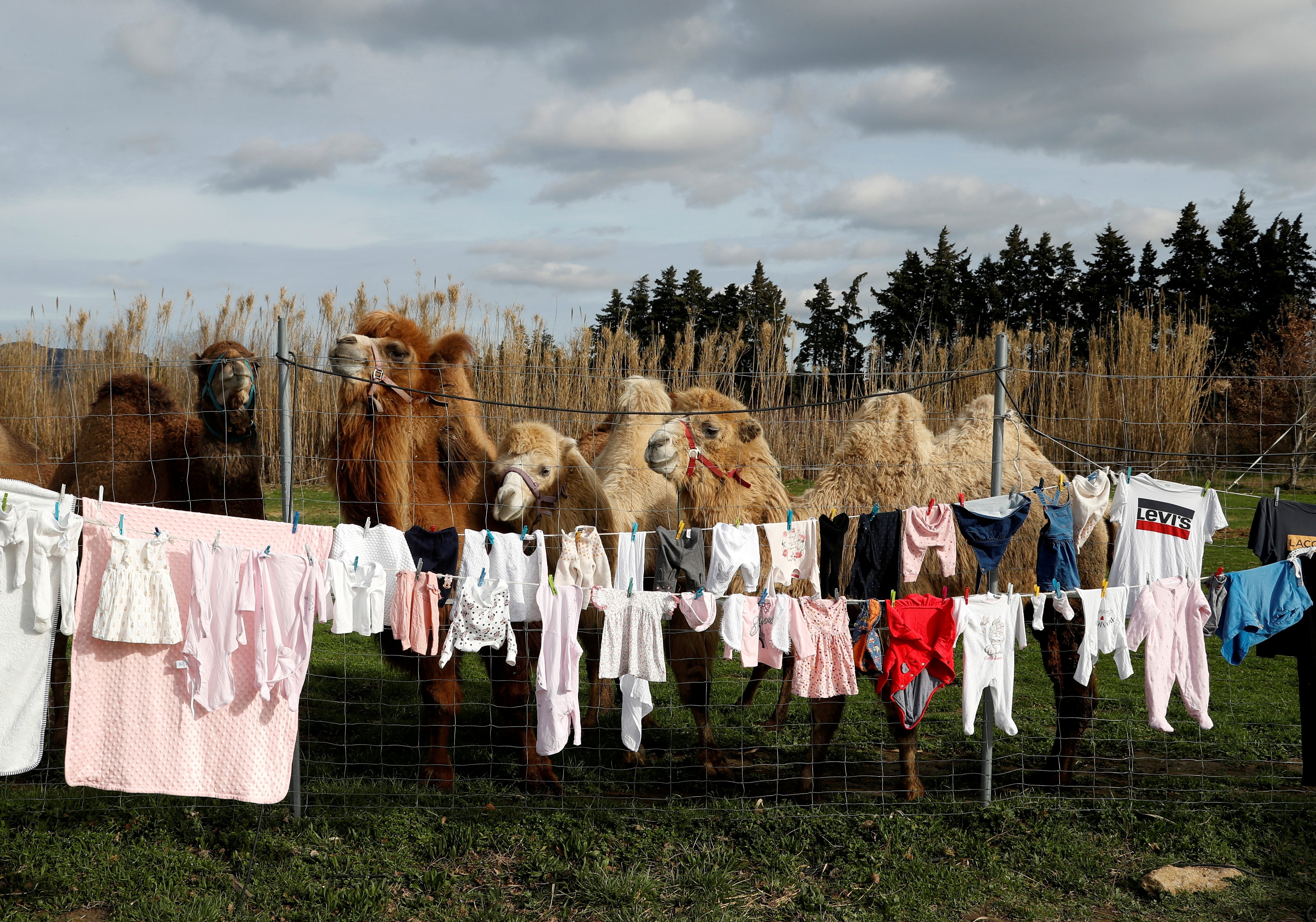
Eric Gaillard
When I met William Kerwich in February 2021, his family’s travelling circus had not performed a show in nearly a year due to Covid restrictions in France. His morale was low with his family parked on a plot of land in southern France and his lions and tigers confined to their pens. Even if the pandemic ended, he faced another threat to his livelihood: France phasing out the use of wild animals in circuses.
His young daughter, Cassandra, trains the animals and I followed her as she fed the tigers, hippo, horses and camels. During the interview, I noticed some washing hung with tiny garments belonging to a newborn baby, but it didn’t make a great photo.
Then I got lucky and a group of camels slowly headed toward the clothes line. I waited for the right moment, hoping the camels did not suddenly go in another direction. It worked perfectly and now I always try to include animals in my photos.
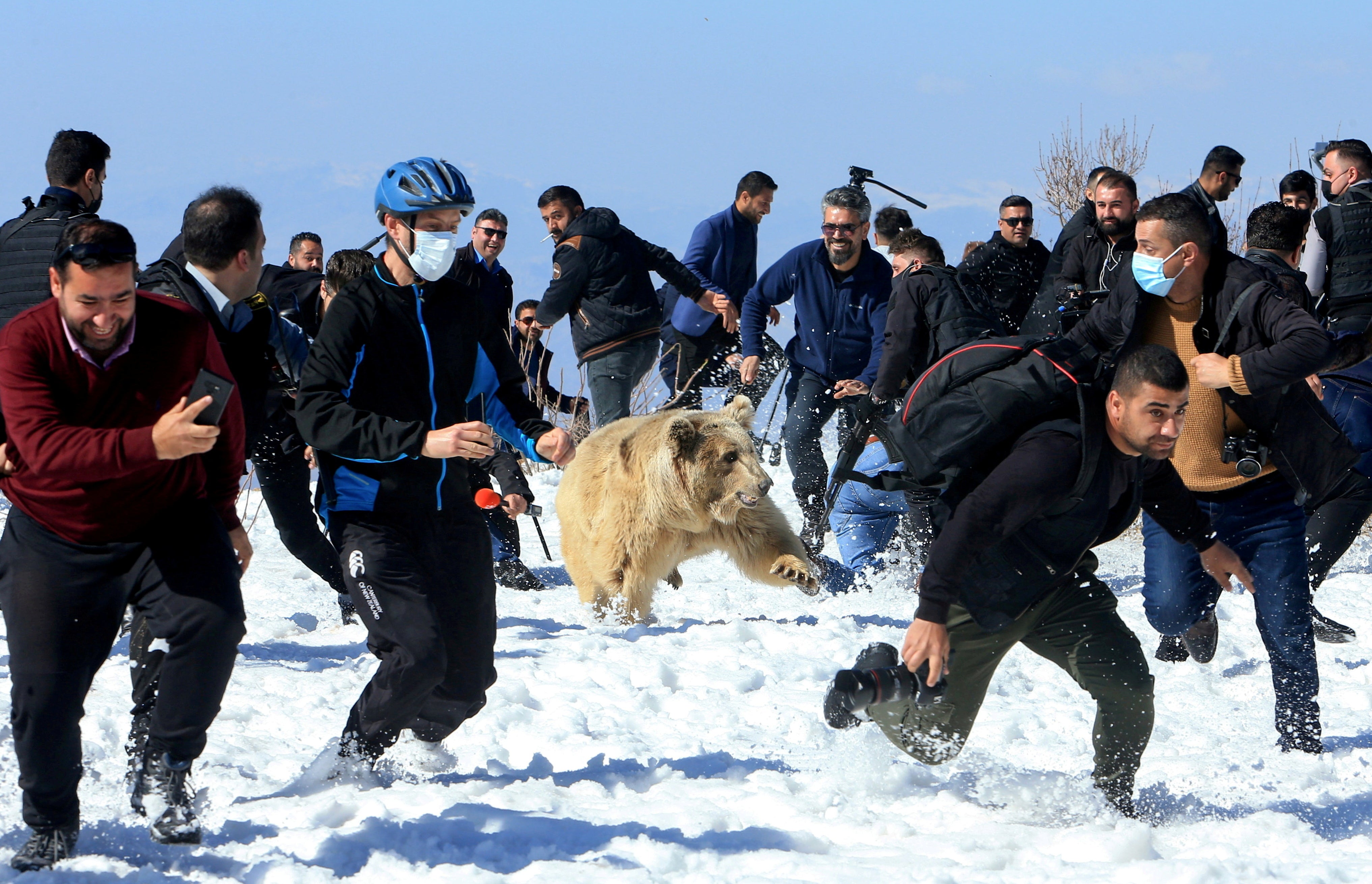
Ari Jalal
In Kurdistan, animal rights activists were rescuing bears from captivity in people’s homes and releasing them back into the wild. This bear had been kept as a pet in a garden in Kurdistan, and this was the moment it was set free. As the bear was let out of its cage, the journalists and onlookers started running. The people were just as scared of the bear as the bear was of them.
Taking photos of wild animals was new to me, but luckily I had spent four hours with the bear the day before. I knew the bear had been raised as a pet so wasn’t aggressive. So when it was released, I understood its behaviour and was not scared of it, unlike the other journalists who ran and screamed. The best thing to do was to stay still and calm.
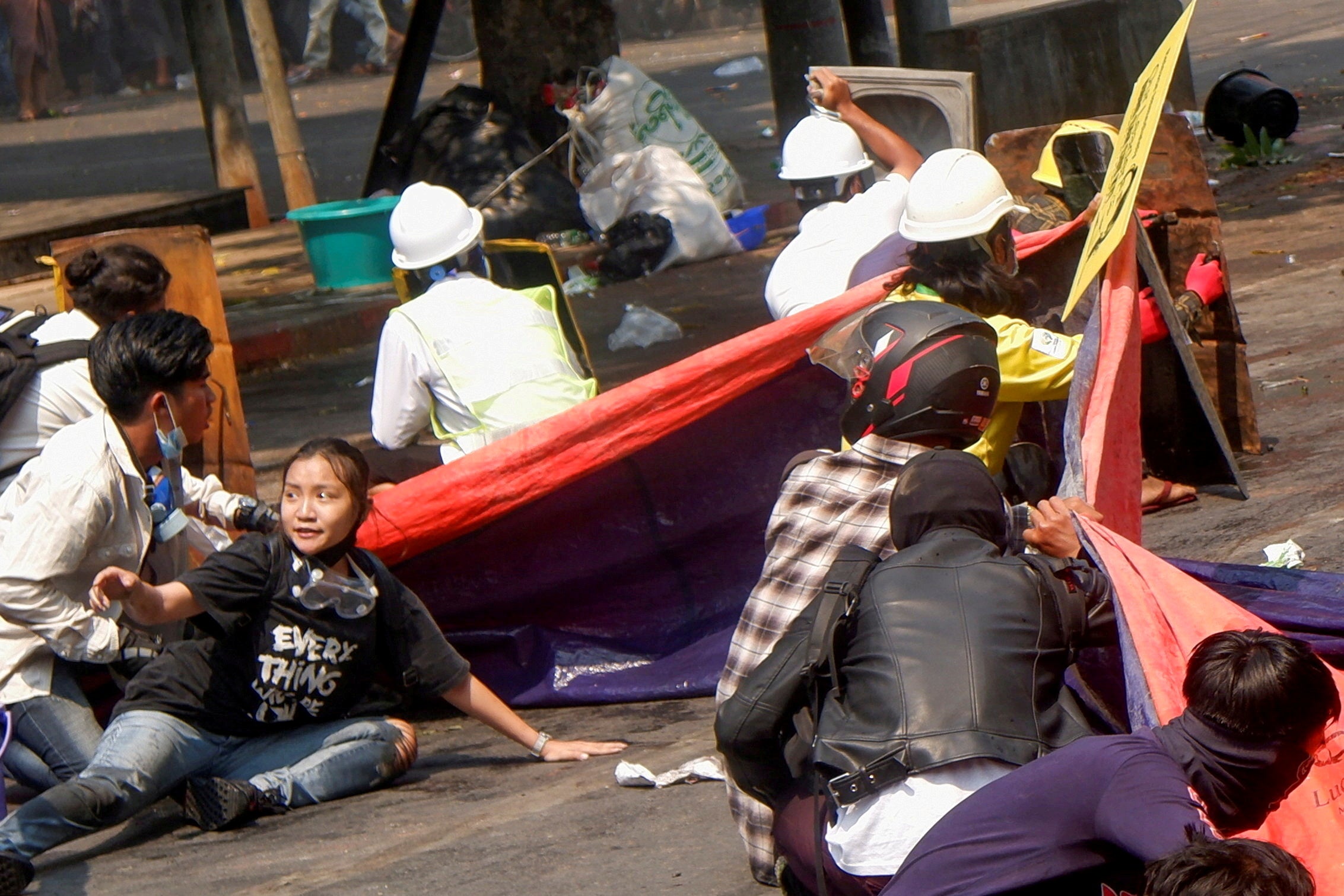
Soe Zeya Tun
Myanmar faced chaos across the entire country after the military coup. I reached out to photographers I knew based in Myanmar to send us photos of the unfolding situation. With the internet cut off across the country, it became challenging to communicate with the photographers on the ground.
Reuters had heard about a young woman named “Angel”, also known as Kyal Sin, who had just been killed at a protest on 3 March. Images of her had begun to circulate on social media. On this particular day we had received photos from a freelance photographer at one of the protests and noticed that they seemed to be from the same protest where Angel had been killed. We asked the photographer, whose identity Reuters is withholding for his security, to carefully look back at all his frames and within minutes he had found four or five frames of Angel just before her death.
The freelance photographer said: “I had been taking photos at the anti-coup protest before police and soldiers started dispersing the protesters. This photo was taken as they began to fire toward the protesters using rubber bullets, live ammunition and tear gas.
“After capturing this image, I was only able to continue taking photos for a couple more minutes before having to take shelter in an apartment nearby, as the situation became too dangerous. The photo was taken a moment before Angel died.”
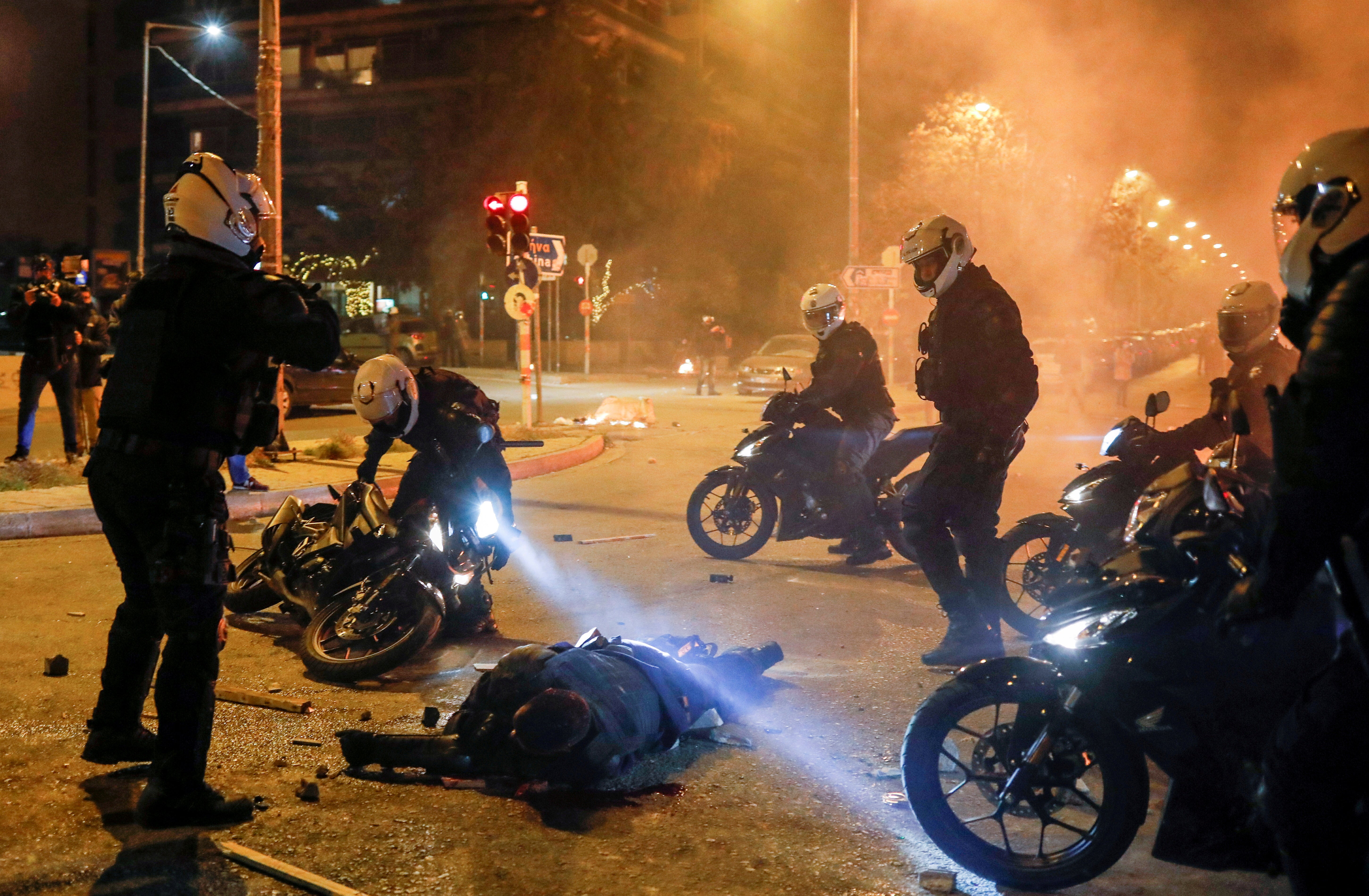
Alkis Konstantinidis
Greece is known for clashes during demonstrations, but protests in 2021 against police violence were some of the most challenging to cover given they took place in populated suburbs at night.
One demonstration unfolded in the Athens suburb of New Smyrni, prompted by a video that appeared to show police officers beating a man during checks on compliance with Covid-19 restrictions. Protesters advanced on a nearby police station with the mood growing increasingly tense. At a police blockade in front of the station, they began throwing petrol bombs, rocks and flares. Riot officers circled the crowd and fired tear gas and a water cannon to try and disperse the protesters.
I moved closer to an underground passageway where the main clashes were taking place. Nearby, I saw a group of police officers on scooters trying to ride through the centre of the demonstration. A large group of protesters grabbed the officer on the last vehicle from behind and dragged him to the ground. Avoiding rocks and petrol bombs, I moved towards the police officer whose colleagues had rushed back to help him. He was seriously injured and not moving. I took a few photos before the area was secured by police units. The officer was treated for cuts, bruises and a concussion and recovered.
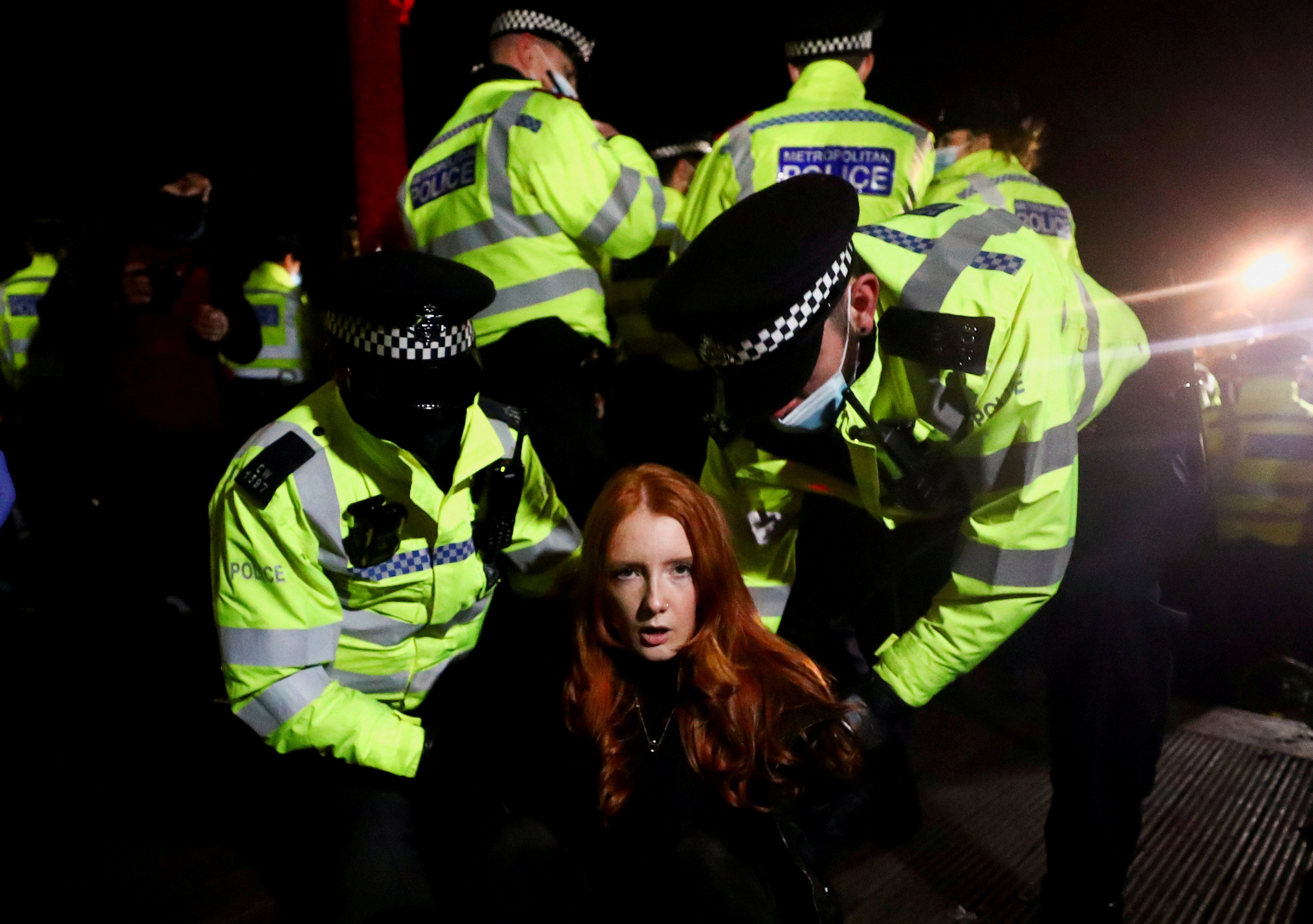
Hannah McKay
This photograph was taken following a vigil for Sarah Everard, a young woman whose kidnap and murder by a serving police officer in London a few days earlier unleashed a wave of revulsion in the UK. It shows a lone female protester, student Patsy Stevenson, being carted off by male police officers. It became an image that captured the national mood of anger at the insecurity women face in Britain and around the world.
I had spent the day on Clapham Common where hundreds of people formed a ring around the bandstand where a minute’s silence was held. As a small group of protestors began addressing the crowd, the police immediately arrived to break up the vigil due to coronavirus restrictions. As it got dark the atmosphere changed, going from a reflective emotional mood to a more angry one.
Patsy was one of the last remaining people on the bandstand and was restrained face down on the floor with her hands behind her back. It was dark, there was lots of shouting and she was clearly distressed. This picture of her on the floor was taken minutes later once the situation had calmed slightly.
I continued to shoot for another hour. It was only when I got home, looked at Twitter and saw the reactions to the protest that I realised how important that image had become. Within days the London police faced backlash for how they broke up the vigil and Everard’s murder resonated with women around the world who have experienced violence and sexual assaults.
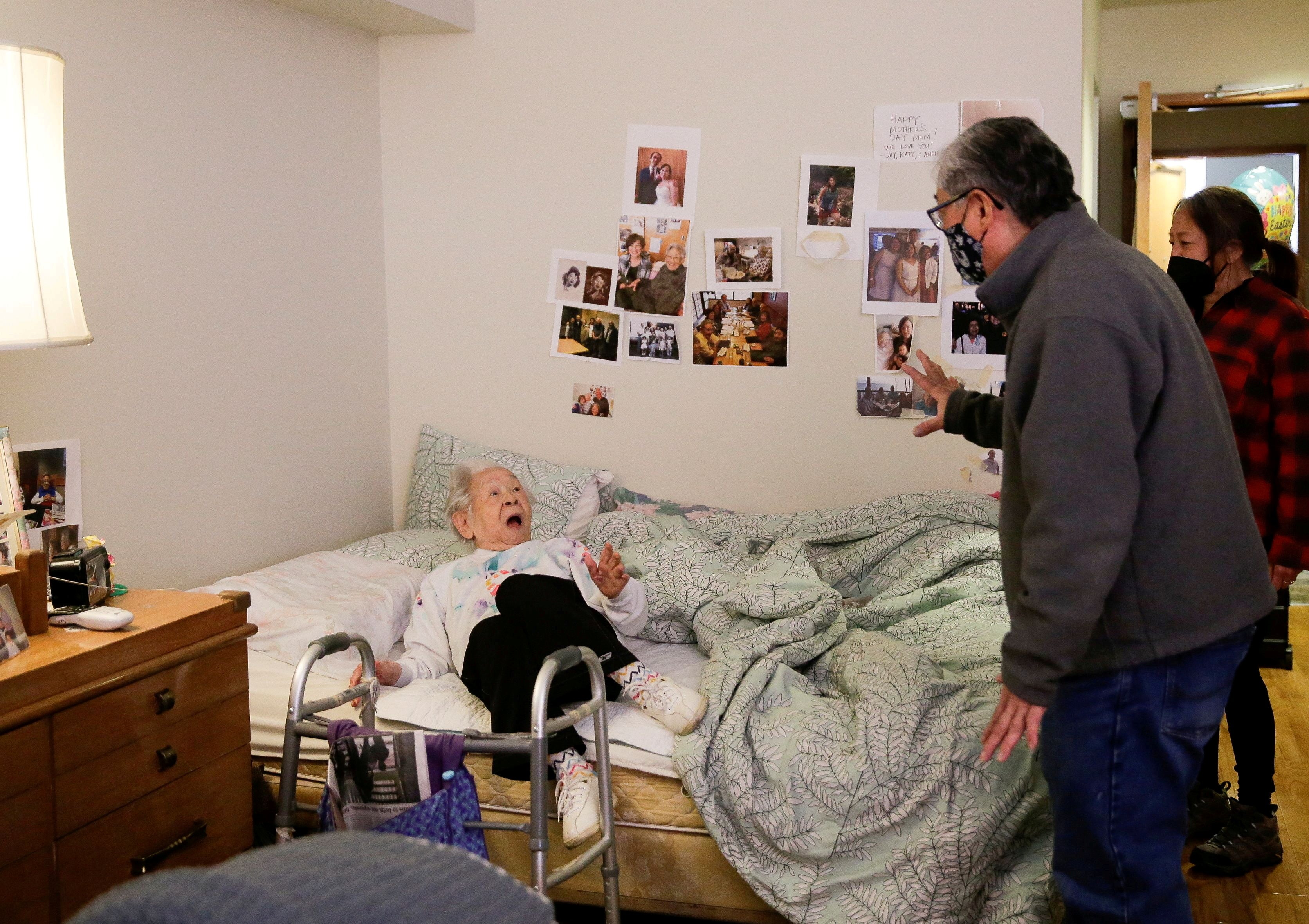
Lindsey Wasson
When Washington state announced nursing homes with residents vaccinated against Covid-19 were able to resume in-person visits, I was able to visit Nikkei Manor in Seattle to photograph a family’s reunion.
Mark Uomoto and his cousin, Gail Yamada, had come to surprise Mark’s 98-year-old mother Yoshia “Yo” Uomoto, their first visit in over a year, as during the pandemic the family could only visit through windows in the lobby.
To capture the moment, I went up to Yoshia’s room with a staff member who told her I was there for a surprise and asked her to cover her eyes. With Yoshia’s eyes covered, Mark and Gail walked in holding flowers and a balloon.
Mark simply leaned over and said quietly, “Hi mom.” Yoshia uncovered her eyes and exclaimed, “It’s so nice to see you!” and reached for a hug. I felt very lucky to be there for their reunion.
The photo went viral, and I know Mark and his family got a kick out of being interviewed by the Today show. I think the photo resonated with so many people because it represented the feelings of excitement and relief that everyone was experiencing as they reconnected with their family after such a difficult year. It had a lot of personal meaning for me as my great-grandmother had lived at Nikkei Manor for several years before she passed away in 2011.
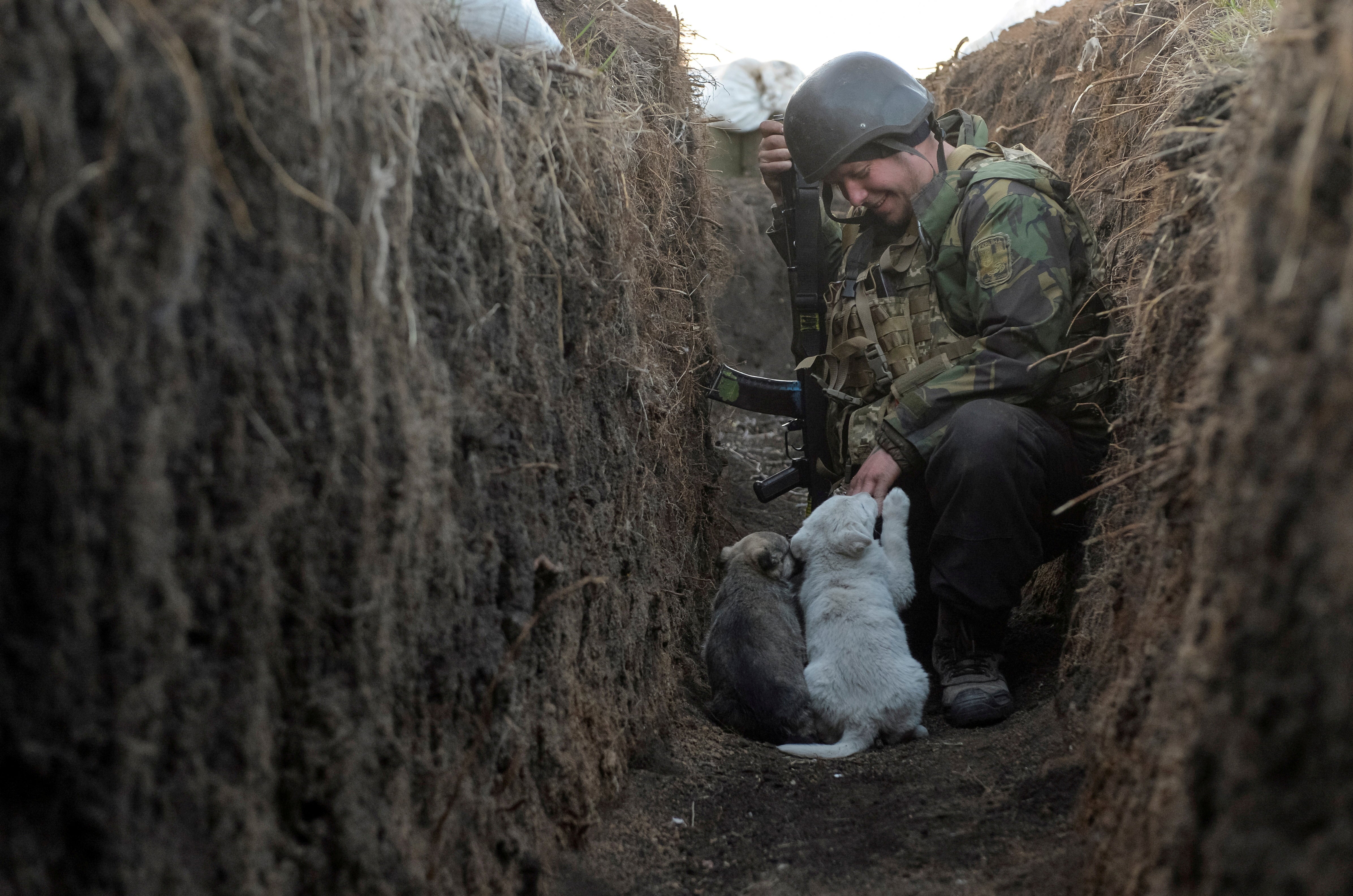
Oleksandr Klymenko
In April 2021, I was photographing Ukraine soldiers on the front line waiting as the world watched in alarm at the large build-up of Russian troops on the country’s border. I had arrived at this position at 5.15am, after it had been fired on by pro-Russian rebels in the self-declared Donetsk People’s Republic (DPR) in the night.
Vova, the soldier in my photograph, had shown me the edge of the trench, where enemy snipers often shoot, as the sun rose. As we sat down I noticed a puppy run towards Vova, then another. As he stroked the puppies I watched as Vova’s face changed, becoming gentle and thoughtful. Vova told me the puppies had only recently been born and are looked after by the soldiers. “We feed them what we eat ourselves,” he said. For soldiers constantly living in such danger, the unconditional kindness and affection from an animal can remind them of home and a more peaceful life.
After 20 minutes in this position, we heard the shot of an enemy mortar and fled for cover. Three hours after I left, a sniper wounded a Ukrainian soldier. We reporters often witness violence, destruction and death, but seeing a soldier in the trenches show kindness and tenderness to animals reminds me of the good and humanity in the world.
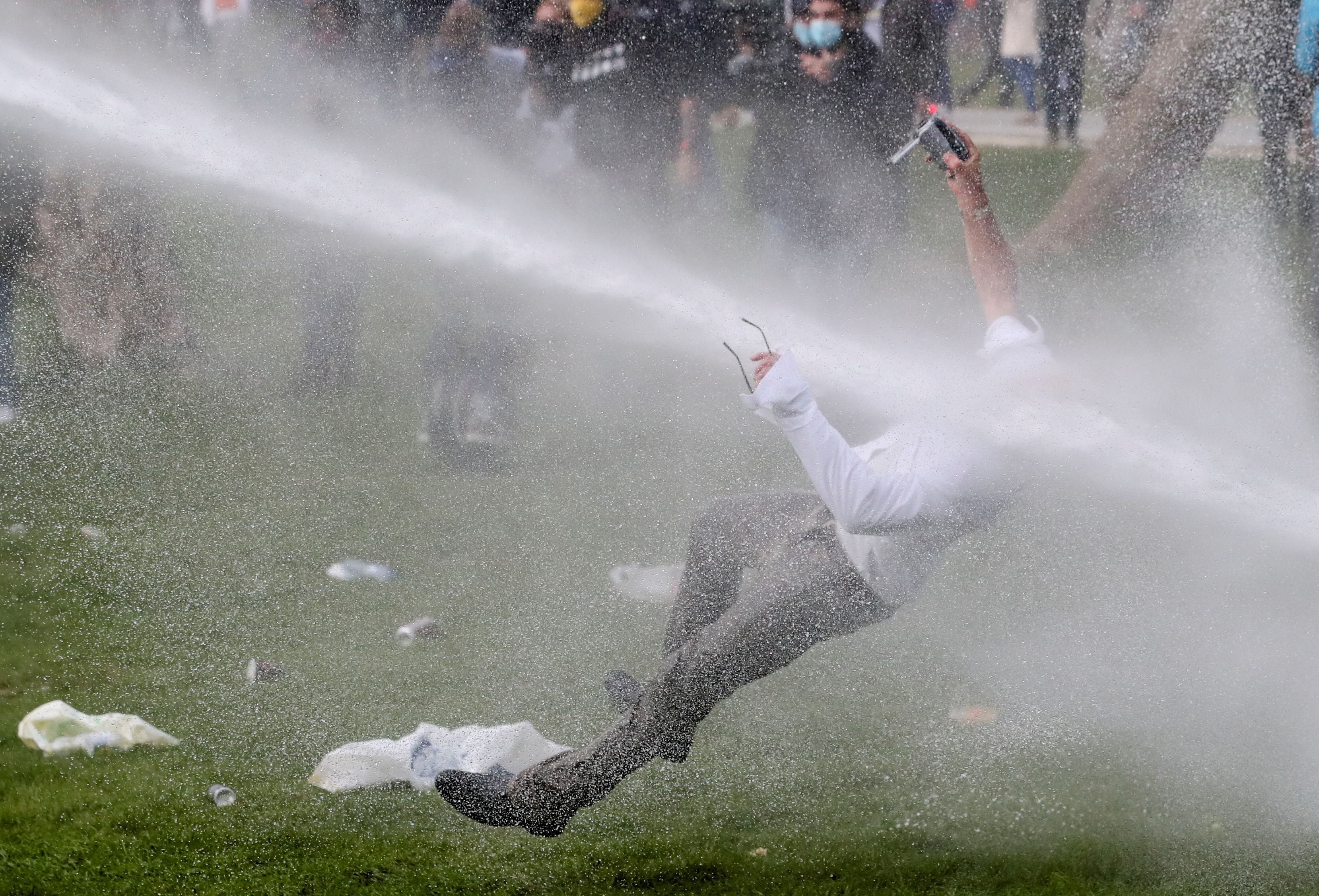
Yves Herman
To contain a rising wave of Covid-19 infections, Belgium announced in March its third lockdown since the pandemic started, closing schools and most businesses for four weeks.
Bristling at the restrictions, a group on Facebook announced an unauthorised party, or “La Boum”, would take place in a park in Brussels. The gathering, which attracted about 2,000 people, was in defiance of the government’s limit of no more than four people together outside.
The clashes between police and protesters took place in several locations in the park. The man in the photo, being doused by a police water cannon, is a former teacher who decided to take part in the gathering. He had begun to walk toward the police cordon as the water cannon was fired. The man was not seriously injured.
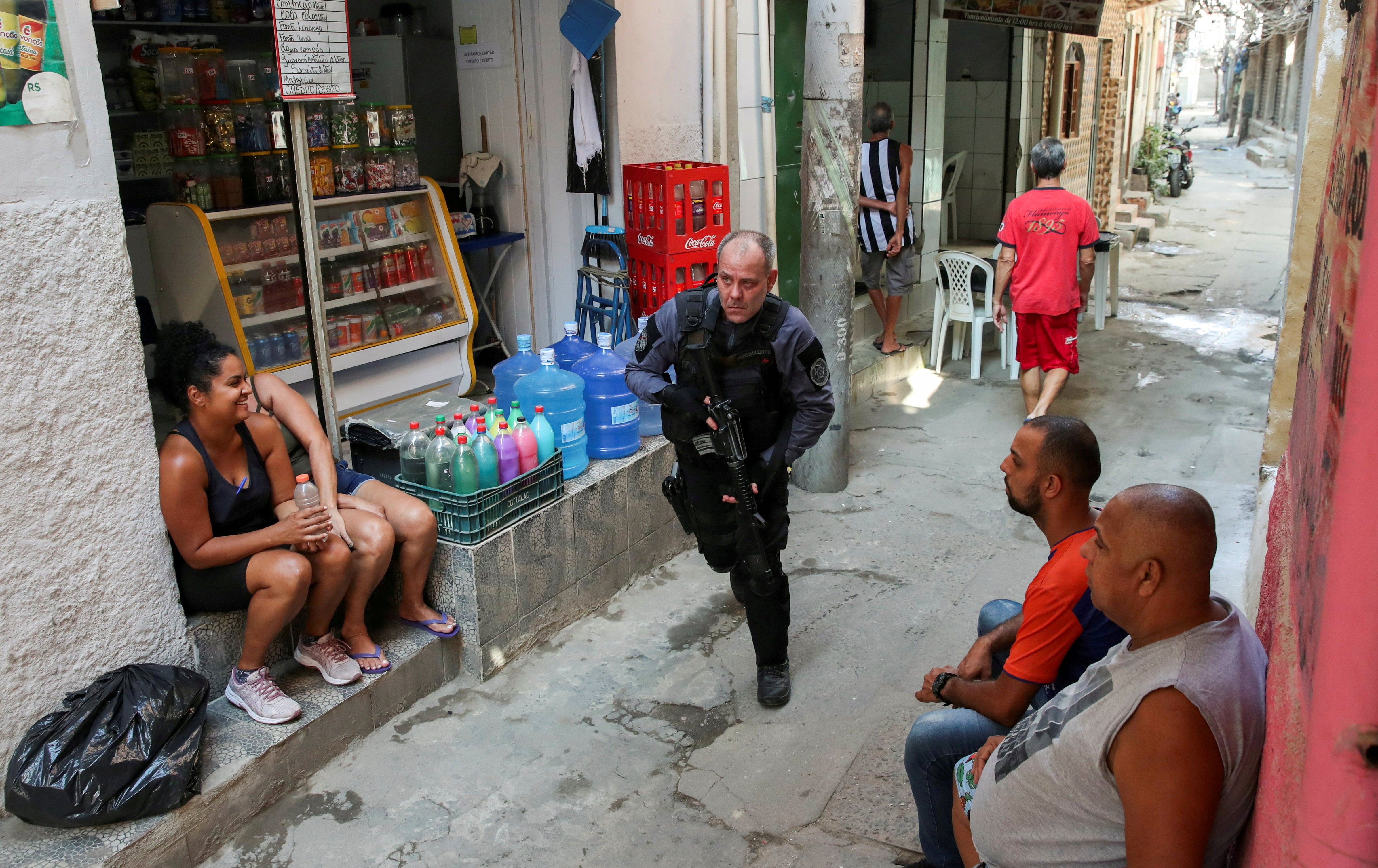
Ricardo Moraes
Silent empty streets, that was how I found the Jacarezinho slum when I arrived to cover a police operation that would end in 28 deaths, the most lethal in the history of Rio de Janeiro. With shops closed and without the normal unrelenting movement of people and motorcycles, the tension showed. After walking around the community for a couple of hours without finding much to photograph, I considered giving up.
I continued circling and came across a group of police officers making an incursion through the empty alleys of the favela. Taking photos carefully, little by little, so as to avoid them making me leave, I followed them through the streets. By this point the operation had been going on for hours and as the sound of shooting stopped, locals slowly began going back to their daily life and businesses started to reopen.
The territory’s control by drug dealers means that the favela of Jacarezinho, and the workers and families who live here, are used to enduring bouts of violence on a daily basis, and this day was no different. At times, cameras can cause more uproar than police guns.
The police, still at work, progressed through the alleys, pointing their guns in all directions. I passed by two bars where people watched the news or chatted in the street. When the police officers ran past with their weapons, residents showed no reaction. They talked, laughed and joked among themselves, while the tense officers searched for members of a gang.
By the end of the day, 28 people had been killed, including a police officer.
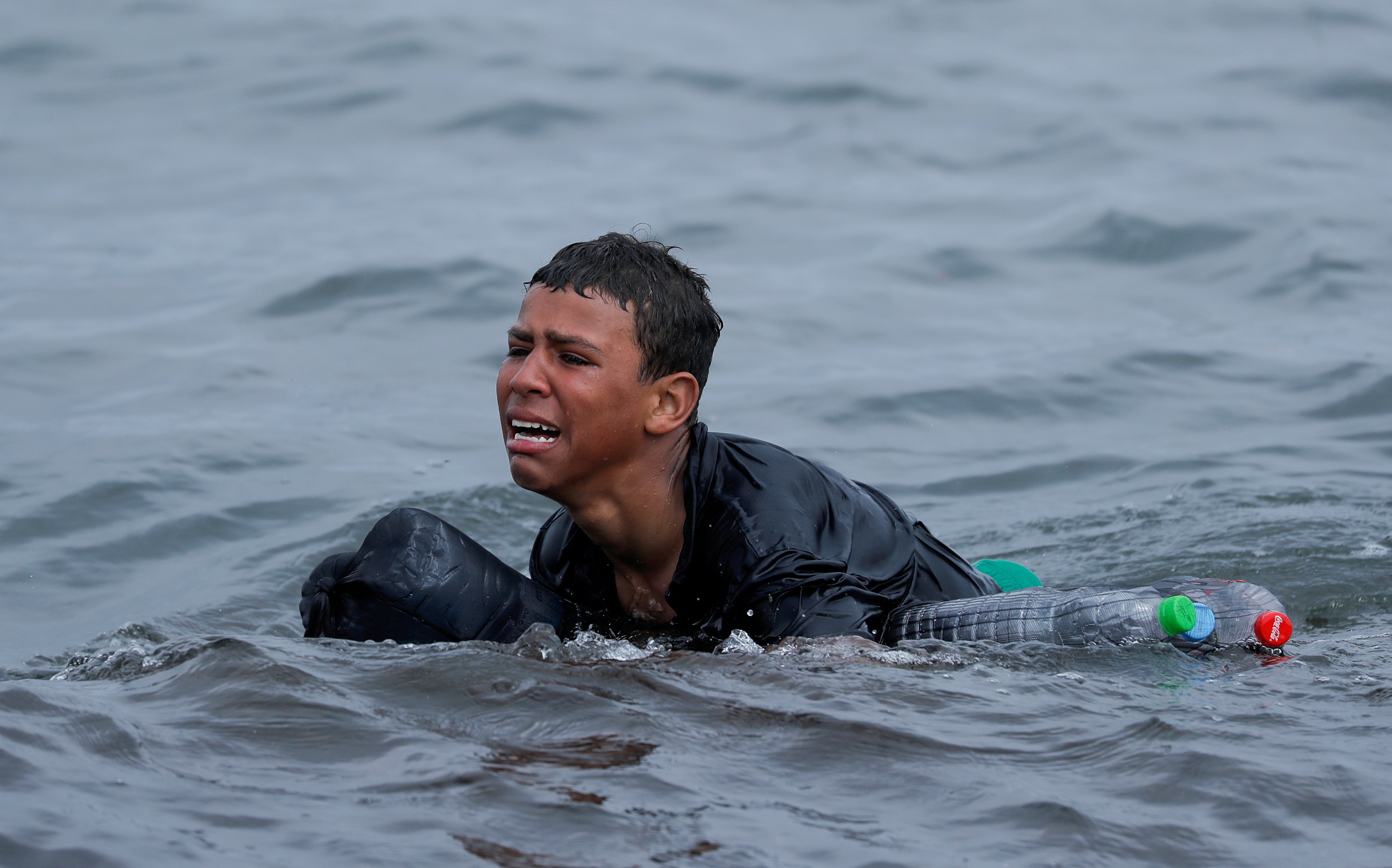
Jon Nazca
Southern Spain is home to one of the planet’s most lethal migration routes. Between the African and European continents a constant humanitarian drama plays out. People from across Africa, mainly Moroccans and Algerians, take to the sea in small boats, crossing the Straits of Gibraltar, the Mediterranean and the Atlantic, to try and reach Europe. They are fleeing war, poverty and dictatorships in their home countries. More than 10,000 migrants of all ages crossed the border during a single week in mid-May, many of them children and mothers with babies.
One of these migrants making the journey was 16-year-old Achraf, who has swum from Morocco to the Spanish enclave of Ceuta. I took his picture from the shore as he swam on his back on the second day of my assignment there.
When I first arrived at the border between Spain and Morocco it felt as though I had found myself on the set of a war film. Hundreds of migrants were desperately swimming at full pelt for Spanish soil, while thousands more rested on the shore, exhausted, after having made it to Spain.
Soldiers in tanks and rescue boats received them on the shore and helped them along the beach as the Moroccan authorities looked on impassively.
Among all those swimming, one in particular caught my eye. It was Achraf, the only one to have fashioned a float out of nine plastic bottles tied around his body in case his strength failed him.
From when I took the first photograph to the moment he reached dry land he was swimming for almost an hour without rest. The heat was scorching but the sea was ice cold. I followed him all along the shoreline for more than 500 metres as he tried to avoid the soldiers posted on the beach and escape inland. As he was swimming, Achraf begged the soldiers between tears. “Try to understand us, for the love of God ... I would prefer to die of cold, I don’t want to go back, I don’t have any family in Morocco.”
I was shooting photos and video at the same time, a challenge carrying two cameras, but I was able to capture Achraf’s desperation and his cries as he realised he was going to be detained by soldiers. He had reached the shore, but was arrested and would be returned to Morocco. He begged the soldiers: “They’re going to beat me, please I don’t want to go back.”
At the time I knew nothing of Achraf’s life in Morocco, why he had chosen to risk everything at such a young age, but I was intrigued by his intelligence at fashioning that improvised float to make sure he didn’t die at sea. Later I learned that his mother had abandoned him when he was a child, and his adoptive mother had also died. Now he lived with a third woman. Achraf had absolutely nobody in Morocco and was only trying to get away to find a better life in Europe.
Reuters
Join our commenting forum
Join thought-provoking conversations, follow other Independent readers and see their replies
Comments